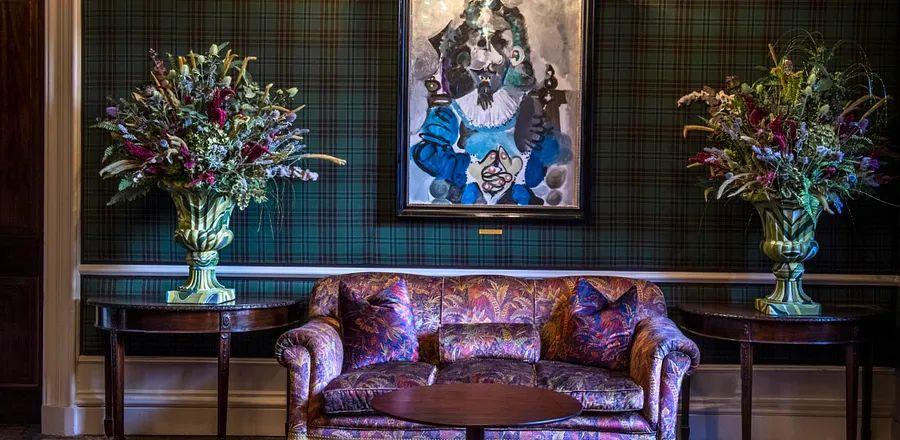At This Opulent Hotel in Scotland, You Can Rest Surrounded by World-Class Art

The Dinogo perspective
A Picasso is watching me closely. Not the Picasso, but a version of him. Pablo’s 1953 La femme assise dans un fauteuil, or Woman Seated in an Armchair, is displayed right above my afternoon tea at the Fife Arms hotel in Scotland. Its subject, Françoise Gilot (an artist and one of Pablo’s muses), seems to disapprove of my selection of fruit tea. With her furrowed brows—though given this is cubism, those might not even be eyebrows—La femme is a stunning masterpiece, her oranges, greens, and blues creating an unexpected harmony with the hotel’s forest-green tartan wallpaper. I can’t help but gaze back, fighting the impulse to kneel on the couch and examine Gilot’s features up close. While it’s not unusual for hotels to showcase prized artworks, having a Picasso among 14,000 pieces and artifacts? It’s no surprise that countless travelers flock to this former hunting lodge nestled in a tiny Highland village, two hours north of Edinburgh.

Image courtesy of the Fife Arms
The setting
Rural Aberdeenshire is far from being “undiscovered.” Queen Victoria was an early admirer of Deeside, a picturesque area stretching about 80 miles along the River Dee, from Aberdeen in the east to Braemar (where I currently am). Captivated by the majestic mountains, heather-covered moors, and salmon-rich streams within what is now Cairngorms National Park, Prince Albert purchased the Balmoral estate for Queen Victoria in 1852, creating one of the modern royal family's cherished retreats. Before their arrival, the nearby Braemar Castle—just a 15-minute drive away—served a crucial role as a stronghold during the Jacobite Rising of 1715.
With the royal family came their entourage, leading to a transition from spoken Gaelic in Braemar to English. Hunting lodges and dining establishments emerged, and today, Braemar is a vibrant village of around 450 permanent residents—though it swells to tens of thousands during the Braemar Gathering, the largest event of the Highland Games, held every early September.
On a Tuesday evening in late September, shortly after 8 p.m., the only sounds I hear in Braemar are the birds. Loud, chattering caws from the trees above the Invercauld Mews Bar seem to echo, shouting at full volume, “Go away! The bar is closed on Mondays and Tuesdays!” Fine, I reply, continuing my post-dinner stroll down the village's main thoroughfare. To my right stands the Bank of Scotland, open just two days a week for a mere four hours each day. To my left are specialty shops: the sporran store, the chocolate shop, and the Hungry Highlander fish and chip shop—also closed.
Aha! A light glows in the window at Farquharsons Bar and Kitchen, named after the Bonnie Prince Charlie-supporting Clan Farquharson; the interior appears warm and inviting. The bar is bustling, the kitchen working hard, with plates of haggis and tatties being served to eager patrons. Meanwhile, the Flying Stag across the street is busy as well; half pints of a porter-like beer (upon closer inspection: a smooth Nitrous Engine Oil dark ale) flow generously.
If it weren't for those two pubs, Braemar would seem like a quiet village, as if everyone were tucked away in bed for the night. This charming little stone village, with its neat two-story homes and a doctor who still makes house calls, would perfectly fit the setting of a Robert Galbraith murder mystery.
Pablo Picasso’s Woman Seated in an Armchair is a stunning piece of art, harmonizing her oranges, greens, and blues with the unexpected complement of the forest-green tartan wallpaper in the hotel drawing room.
The accommodations
Every one of the 46 guest rooms and suites reflects a connection to Braemar or Scottish heritage. The “Scottish Culture Rooms” draw inspiration from prominent figures in literature, science, politics, and the arts, including everyone from Lord Byron to suffragist Elsie Inglis and Robert Louis Stevenson, who penned much of Treasure Island in Braemar. The “Nature and Poetry” rooms celebrate the flora and fauna of the Scottish Highlands and their representation in literature. Each room is distinct and beautifully crafted—so inviting that one might easily spend an entire afternoon writing at the handcrafted wooden desk, reading the complimentary book of Fife Arms poetry while cozy under a wool blanket, and counting all the dog portraits and porcelain pieces in the room.
Let’s address this upfront: For every bottle of single malt and piece of art, there’s an abundance of taxidermy. Plenty of taxidermy—hundreds of specimens, displayed behind glass, scaling a wall and creeping across the ceiling. Considering the area's natural history and the building's heritage as a hunting lodge, this choice isn’t shocking, but it can be a bit startling until it fades into the background. Also gracing the background are sketches by a young King Charles and a commissioned mural by Argentine artist Guillermo Kuitca adorning the dining room walls. The real luxury lies in the vast amount to explore within this building, making it feel like a livable museum. Outside, the natural splendor of the Highlands awaits, equally enchanting.

Image courtesy of the Fife Arms
Culinary offerings
As a lively community hub, the street-facing Flying Stag is a vibrant pub serving generous portions of Scottish comfort food (think pork sausage and mash, fish pie, haggis/neeps/tatties). There are plenty of cozy spots for a quiet dinner; just look for the well-loved armchair tucked away in the far left corner.
In addition, the main Clunie Dining Room offers a hearty and delicious daily breakfast, dinner, and Sunday roast, all set against a stunning cubist mural by Guillermo Kuitca. Don't skip the carbs here: the sourdough bread and butter are standout features. Next door, champagne and cocktails flow in the “jewel box of a bar,” Elsa’s, inspired by fashion designer Elsa Schiaparelli, who watches over the lounge in a 1931 Man Ray photograph. Personally, I enjoyed the tea service and small bites most, whether enjoyed in the lounge or in the garden outside.
Staff and service
Meeting new faces in Braemar is a breeze with just a few introductions—something the hosts at the Fife Arms are more than happy to facilitate. "Would you like to join a hike in Cairngorms National Park with the former hunting guide to the Queen of England?" they suggest. Or perhaps a local history walking tour with Simon Blackett, the chief storyteller of Yellow Welly Tours, who knows everyone in town? You could also enjoy a guided tour of the hotel's art collection followed by a whisky tasting in our library.
Yes, please, to all of the above. This fall and winter, for an extra fee, guests can reserve a "whisky afternoon tea" ($65 per person); a full-day survival skills workshop—learning to make fires, forage, and identify plants—led by the head instructor of Highland Survival Skills; and an adventure under the dark skies to a secluded area of the Cairngorms. The guides may share local legends, provide expert insights about the constellations and local flora and fauna, or discuss any other topics you desire. They are part of the Fife Arms’ ghillies, a Gaelic term for hunting and fishing guides, here acting as concierges to arrange these immersive local experiences.
The story behind all that art
The Fife Arms was never intended to be merely a place for a good night's sleep. In 2019, its Swiss owners, Iwan and Manuela Wirth, prominent contemporary art dealers and co-presidents of Hauser & Wirth, reopened the Victorian-era coaching inn as a venue infused with soul: where world-class contemporary art coexists with 16th-century Scottish antiques, creating a space where the community gathers for a pint and takes guests out on adventures.
The Wirths first discovered Braemar during a leisurely visit. Upon seeing the impressive Fife Arms building, with its distinctive multi-gabled roof and chimney stacks, they remarked, "We could create something wonderful here." With the assistance of Moxon Architects and Russell Sage Studio, the renovation and restoration spanned four years. During this time, the Wirths gathered furniture, art, and decor from their personal collection as well as estate sales throughout the Highlands, uncovering a stunning 19th-century mahogany “Robert Burns” mantelpiece to complement works by Picasso and Louise Bourgeois.
“Every item [in the hotel] must have a purpose,” Iwan Wirth stated. “It’s not sufficient for something to merely be beautiful or functional. We need to have a story to tell about everything.” Prices start at $496

1

2

3

4

5
Evaluation :
5/5